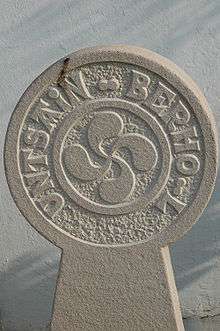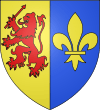Ascain
| Ascain | ||
|---|---|---|
|
Main street in Ascain | ||
| ||
 Ascain | ||
|
Location within Nouvelle-Aquitaine region  Ascain | ||
| Coordinates: 43°20′48″N 1°37′12″W / 43.3467°N 1.62°WCoordinates: 43°20′48″N 1°37′12″W / 43.3467°N 1.62°W | ||
| Country | France | |
| Region | Nouvelle-Aquitaine | |
| Department | Pyrénées-Atlantiques | |
| Arrondissement | Bayonne | |
| Canton | Saint-Jean-de-Luz | |
| Intercommunality | Sud Pays Basque | |
| Government | ||
| • Mayor (2014–2020) | Jean-Louis Fournier | |
| Area1 | 19.27 km2 (7.44 sq mi) | |
| Population (2010)2 | 4,001 | |
| • Density | 210/km2 (540/sq mi) | |
| Time zone | CET (UTC+1) | |
| • Summer (DST) | CEST (UTC+2) | |
| INSEE/Postal code | 64065 / 64310 | |
| Elevation |
5–883 m (16–2,897 ft) (avg. 52 m or 171 ft) | |
|
1 French Land Register data, which excludes lakes, ponds, glaciers > 1 km² (0.386 sq mi or 247 acres) and river estuaries. 2 Population without double counting: residents of multiple communes (e.g., students and military personnel) only counted once. | ||
Ascain (Basque Azkaine) is a French commune in the Pyrénées-Atlantiques department in the Nouvelle-Aquitaine region of south-western France.
The inhabitants of the commune are known as Azkaindar.[1][2]
The commune has been awarded three flowers by the National Council of Towns and Villages in Bloom in the Competition of cities and villages in Bloom.[3]
Geography

Ascain is part of the urban area of Bayonne in the traditional Basque province of Labourd 13 km east of Irun and 7 km (4.3 mi) south of Saint-Jean-de-Luz and the Atlantic Ocean in the western foothills of the Pyrenees. The southern tip of the commune touches the border with Spain at the peak of Larrun mountain. Access to the commune is by the D4 road from Urrugne in the north-west coming into the commune from the west then passing through the town and continuing south-east to Sare. The D918 also comes from Saint-Jean-de-Luz in the north and passes through the north of the commune between two urban areas and continuing east to Saint-Pée-sur-Nivelle. Some 30% of the commune is residential with some small forests in the north and farmland mostly in the south with some farms in the north.[4]
The summit of Larrun, a mountain iconic of the Basque country, is situated approximately 6 km (3.7 mi) south of the town at the southern tip of the commune on the border with Spain. The summit can be reached by the Petit train de la Rhune, which commences from the Col de Saint-Ignace, 4 km (2.5 mi) to the east of the town outside the commune on the D4 road to Sare.
The Interurban Network of Pyrénées-Atlantiques bus line has two stops in the commune: one for Route 863 which runs from Hasparren to Saint-Jean-de-Luz; and Route 858 between Sare and Saint-Jean-de-Luz.
The Nivelle river flows through the north of the commune flowing towards the west parallel to the D918 on its way to the Atlantic Ocean. Several tributaries rise in the south of the commune and flow north, gathering many more tributaries, into the Nivelle. These streams include the Aniberreko Erreka, the Galardiko Erreka, and the Arraioko Erreka. The Larrunko Erreka forms the south-western border of the commune as it flows north then west to join the Intsolako Erreka which continues north to join the Aniberreko Erreka.[4]
Places and hamlets[5]
- Aïra-Harri[6]
- Aldagarai
- Ansorlua
- Apituxenborda
- Arginenia
- Arraioa
- Askubea
- Biscarzoun[7] or Bizkarzun (redoubt)
- Bordatxoenia
- Dorria
- Errotenea
- Esnaur (redoubt)[8]
- Etxegaraia
- Hiriburua
- Ihizelaia
- Indartea
- Jauregikoborda
- Kisu Labea
- Lanzelai (ZA)
- Larrunzola
- Lur Eder
- Manttobaita
- Martinhaurrenborda
- Miramar
- Monségur
- Morzelai
- Muga[9]
- Nausienborda
- Oihanetxeberria
- Paxkulinenea
- Portua
- Larrun
- Sabadinenborda
- Sainte-Hélène
- Serres
- Telleriaberria
- Xakarroko Errota
- Xeruenborda[10]
- Xorroetaberria
- Xuanenborda
- Zelaia
- Zelaiakoborda

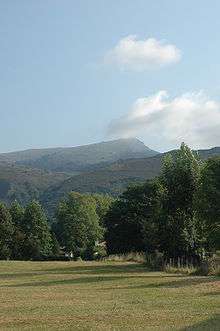


Neighbouring communes and villages[4]
 |
Urrugne | Saint-Jean-de-Luz | Saint-Pée-sur-Nivelle |  |
| Biriatou | |
|||
| ||||
| | ||||
| Spain | Sare |
Toponymy
The commune name in basque is Azkaine.[2]
The name Ascain probably comes from haitz gain meaning "top of the hill" or "rocky height".[11][12]
The following table details the origins of the commune name and other names in the commune.
| Name | Spelling | Date | Source | Page | Origin | Description |
|---|---|---|---|---|---|---|
| Ascain | Escan | 1125 | Goyheneche | Village | ||
| Escan | 1140 | Raymond | Bayonne | |||
| Scain | 1235 | Raymond | Bayonne | |||
| Azcayn | 1302 | Raymond | Chapter | |||
| Scainh | 1450 | Raymond | Labourd | |||
| Ascaing | 1552 | Raymond | Labourd | |||
| Sancta Maria d'Ascaing | 1691 | Raymond | Collations | |||
| Askaine | 19th century | Lhande | ||||
| Harania | Harania | 1863 | Raymond | Hamlet | ||
| Olhaberrietta | Olhaberrietta | 1568 | Orpustan | House: "Place of the new hut" | ||
| Serres | Villa quœ dicitur Asseres | 1140 | Raymond | Bayonne | ||
| Sanctus-Jacobus de Serres | 1691 | Raymond | Collations | |||
| Croix d'Urumendy | Croix d'Urumendy | 1863 | Raymond | Place of Pilgrimage | ||
| Xeruenborda | Chérumborda | 1863 | Raymond | Place of Pilgrimage |
Sources:
- Goyheneche: Eugène Goyheneche, Basque Country: Soule, Labourd, Basse-Navarre[13]
- Raymond: Topographic Dictionary of the Department of Basses-Pyrenees, 1863, on the page numbers indicated in the table. (French)[10]
- Lhande: Basque-French Dictionary by Pierre Lhande.[14]
- Orpustan: Jean-Baptiste Orpustan, New Basque Toponymy[11]
Origins:
- Bayonne: Cartulary of Bayonne or Livre d'Or (Book of Gold)[15]
- Chapter: Titles of the Chapter of Bayonne[16]
- Labourd: Titles of Labourd[17]
- Collations: Collations of the Diocese of Bayonne[18]
History
In 1609 Councillor Pierre de Lancre intervened in French Basque Country at the head of a commission of inquiry demanded by Henri IV. The commission was to "purge the country of all sorcerers and sorceresses under the influence of demons". The priest of Ascain was degraded then burned.[19]
The Bishop of Bayonne, Jean VI de Sossiondo, built a large house called "Askunda" here during the middle of the 16th century, which can still be seen.
In 1794, at the height of The Terror and after the desertion of 47 young people from Itxassou, the Committee of Public Safety (Decree of 13 Ventôse Year II - 3 March 1794) arrested and deported some of the men, women, and children from Ainhoa, Ascain, Espelette, Itxassou, Sare, and Souraïde; and declared the commune, as for other communes near the Spanish border, a "Notorious commune".[20] This measure was also extended to Biriatou, Cambo, Larressore, Louhossoa, Mendionde, and Macaye.
The inhabitants were: "gathered in various national houses or in the District of Ustaritz or in those of the Grande Redoubt, such as Jean-Jacques Rousseau".[21] In reality they were gathered in the churches then deported in very precarious conditions[22] to Bayonne, Capbreton, Saint-Vincent-de-Tyrosse, and Ondres. Departments where people from the communes were interned were Lot, Lot-et-Garonne, Gers, Landes, Basses-Pyrénées (the Béarnais part), and Hautes-Pyrénées.
The return of the exiles and the recovery of their properties were determined by a series of decrees issued on 29 September and 1 October 1794 - driven in this direction by the Director of Ustaritz: "The former communes of Sare, Itxassou, Ascain, Biriatou, and Serres, whose inhabitants have been interned for eight months as a measure of general security people have not been able to farm. The people who wish to obtain freedom to retire to their homes are clamouring for food without us being able to provide them with the means to fulfil this first human need, hunger".[23] The recovery of property was not done without difficulty: their properties had been sequestered but were not registered and so were looted: "Movable and immovable property of the inhabitants of Sare, were neither legally recognized nor disclosed; all our furniture and household effects were removed and brought confusedly to neighbouring communes. Instead of putting them in safe places, some were sold at auction or to any other party without auction".[24]
Heraldry
.svg.png) |
The arms were adopted by the commune on 26 June 1988.
Blazon: |
These arms were registered for the first time on 5 July 1405 by Juan Martinez de Agorreta y Ascain, Lord of Agorreta and Ascain, who married Princess Leonor Tocco de Acciaioli, from the Florence House of Acciaioli.[25][26]
Administration
List of Successive Mayors[27]
| From | To | Name | Party | Position |
|---|---|---|---|---|
| 1808 | 1813 | Michel Monségur | ||
| 1813 | 1814 | Pierre Theillary | ||
| 1814 | 1828 | Michel Monségur | ||
| 1828 | 1837 | Jean Pagès | ||
| 1837 | 1844 | Jean Gracy | ||
| 1844 | 1848 | Raymond Monségur | ||
| 1848 | 1856 | Dominique Hirigoyen | ||
| 1856 | 1864 | Gustave Hillaire Argelliès | ||
| 1864 | 1867 | Raymond Monségur | ||
| 1867 | 1877 | Dominique Hirigoyen | ||
| 1877 | 1883 | Jean called "Ganich" Gracy | ||
| 1883 | 1891 | Jean Etcheverry | ||
| 1891 | 1900 | Jean Larralde | ||
| 1900 | 1904 | Dominique Berho | ||
| 1904 | 1906 | René Minier | ||
| 1906 | 1912 | Jean Gracy | ||
| 1912 | 1919 | Jean Leholaberry | ||
| 1919 | 1924 | René Minier | ||
| 1924 | 1941 | Pierre Pinatel |


- Mayors from 1941
| From | To | Name | Party | Position |
|---|---|---|---|---|
| 1941 | 1945 | Jean-Baptiste Gracy | ||
| 1945 | 1946 | Charles Minier | ||
| 1946 | 1953 | Jean Baptiste Aspirot | ||
| 1953 | 1963 | Jean Baptiste Gracy | ||
| 1963 | 1971 | Robert Minier | ||
| 1971 | 1977 | Jean Sauvé | ||
| 1977 | 2001 | André Luberriaga | DVD | |
| 2001 | 2014 | Jean-Louis Laduche | DVD | |
| 2014 | 2020 | Jean-Louis Fournier |
(Not all data is known)
Inter-communality

The commune is part of eight inter-communal structures:
- the Agglomeration of Sud Pays Basque;
- the AEP association of Nive Nivelle;
- the Energy association of Pyrénées-Atlantiques;
- the inter-communal association for secondary educational colleges of Saint-Jean-de-Luz;
- the inter-communal association for the rescue centre in Saint-Jean-de-Luz;
- the SIED Côte Basque Sud;
- the association to support Basque culture.
- the Basque Bayonne - San Sebastián Eurocity.
Twinning
Ascain has twinning associations with:[28]
 Bollendorf (Germany) since 1979.
Bollendorf (Germany) since 1979. Lesaka (Spain) since 1980.
Lesaka (Spain) since 1980.
Demography
In 1670 the commune had 300 fires and in 1718 1,560 inhabitants.
In 2010 the commune had 4,001 inhabitants. The evolution of the number of inhabitants is known from the population censuses conducted in the commune since 1793. From the 21st century, a census of communes with fewer than 10,000 inhabitants is held every five years, unlike larger towns that have a sample survey every year.[Note 1]
| 1793 | 1800 | 1806 | 1821 | 1831 | 1836 | 1841 | 1846 | 1851 |
|---|---|---|---|---|---|---|---|---|
| 688 | 766 | 820 | 833 | 1,014 | 1,041 | 1,132 | 1,297 | 1,272 |
| 1856 | 1861 | 1866 | 1872 | 1876 | 1881 | 1886 | 1891 | 1896 |
|---|---|---|---|---|---|---|---|---|
| 1,113 | 1,162 | 1,116 | 1,171 | 1,173 | 1,212 | 1,225 | 1,150 | 1,128 |
| 1901 | 1906 | 1911 | 1921 | 1926 | 1931 | 1936 | 1946 | 1954 |
|---|---|---|---|---|---|---|---|---|
| 1,157 | 1,178 | 1,240 | 1,216 | 1,354 | 1,510 | 1,460 | 1,376 | 1,474 |
| 1962 | 1968 | 1975 | 1982 | 1990 | 1999 | 2006 | 2010 | - |
|---|---|---|---|---|---|---|---|---|
| 1,605 | 1,683 | 1,876 | 2,159 | 2,653 | 3,097 | - | 4,001 | - |
Sources : Ldh/EHESS/Cassini until 1962, INSEE database from 1968 (population without double counting and municipal population from 2006)

Economy
Economic activity is mainly agricultural and also tourism. There is a sandstone quarry in the commune.
Ascain is part of the Appellation d'origine contrôlée (AOC) zone of Ossau-iraty.
There are two breweries (Akerbeltz and Oldarki) in the commune.
Culture and heritage
According to the Map of the Seven Basque Provinces edited in 1863 by Prince Louis-Lucien Bonaparte, the basque dialect spoken in Ascain is Labourdin.
The film La Danseuse Orchidée by Léonce Perret was partly filmed in Ascain in 1928 with Chiquito de Cambo.
Civil heritage
There are several buildings and structures in Ascain that are registered as historical monuments. These are:
- House of Ferdinand Pinney Earle (20th century)
 [9]
[9] - Redoubt of Biscarzoun (partly in Saint-Pée-sur-Nivelle) (19th century)
 [7]
[7] - Redoubt of Esnaur (1813)
 [8]
[8] - Roman bridge on the Nivelle (5th century)
 .[29] It was rebuilt after the collapse of the central pier caused by flooding of the Nivelle in December 1994.
.[29] It was rebuilt after the collapse of the central pier caused by flooding of the Nivelle in December 1994. - Group of nine Stone circles at Aïra-Harri (Protohistoric)
 [6]
[6]
The two redoubts were part of the defence by Marshal Soult of the Franco-Spanish border against the British Army under Wellington in 1813.
In 1947 the village erected the first Stèle des évadés de France (Stele of escapees of France) in memory of the resistance fighters who left France to join the Free French Forces via Spain during the Second World War.
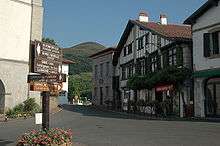 Bilingual signs |
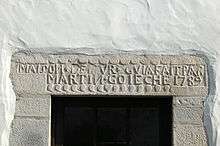 Lintel on a House |
 The fronton in the square |
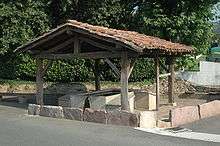 The Lavoir (public laundry) |
Religious heritage
The Church of the Assumption![]() [30] has some medieval remains. It was enlarged in the 16th and 17th centuries and was inaugurated under Louis XIII in 1626. In 1605 Monseigneur Bertrand d'Etchaux, Bishop of Bayonne, visited the parish of Ascain and permitted "the said parishioners of the said parish to sell or dispose of the tombs that seem good in favour of the proceeds of the sale"... (be used for) ..."the keeping, repair, and completion of the work on the church".[31]
[30] has some medieval remains. It was enlarged in the 16th and 17th centuries and was inaugurated under Louis XIII in 1626. In 1605 Monseigneur Bertrand d'Etchaux, Bishop of Bayonne, visited the parish of Ascain and permitted "the said parishioners of the said parish to sell or dispose of the tombs that seem good in favour of the proceeds of the sale"... (be used for) ..."the keeping, repair, and completion of the work on the church".[31]
Inside the church is a Statue of the Virgin and Child![]() [32] which is a cast of a statue from the 14th century: the original in marble, called the Virgin of Longchamp, is preserved in the Musée national du Moyen Âge (National Museum of the Middle Ages) in Paris. Tombstones in pink sandstone from Larrun cover the grounds.
[32] which is a cast of a statue from the 14th century: the original in marble, called the Virgin of Longchamp, is preserved in the Musée national du Moyen Âge (National Museum of the Middle Ages) in Paris. Tombstones in pink sandstone from Larrun cover the grounds.
-
Church of the Assumption at Ascain
-
Modern Virgin
-
Plaque in pink sandstone from Larrun dating to 1648
-
Clock on the church
-
Church entrance
-
Statue
-
Pulpit and gallery
-

The Altar
-
Bas-relief
-
The Nave
-
Statue of Saint Antoine
-
Hilarri
-

Swastika Hilarri
-
Stele of General Jean-Pierre Ritter
The Chapel of Serres, dedicated to Saint Jacques and recently restored was, in the Middle Ages, a waystation on the Way of St. James.[33]
Facilities
Education
The commune has three primary schools: one public, one private catholic (Sainte-Marie school), and one Ikastola (Basque language school).[34]
A Music school (Kornelio), in the form of an associatrion offers classic and traditional training.[35]
The Larrundarrak drum band, the Larrun Kanta choir, and the Martintxo-Altxalili association complete the musical offerings of the commune.[35]
Sports and Sports facilities
There are several sports associations in the commune including associations for athletics, basketball, cycling, traditional dance, gymnastics, basque pelota, hiking, rugby union, and tennis.[35]
Notable people linked to the commune
- Johannes de Sossiondo, born at Ascain, Bishop of Bayonne from 1566 to 1578;[36]
- Edmé-Martin Vandermaesen, born in 1766 at Versailles and died in 1813 at Ascain, was a Divisional general, mortally wounded at Saint-Jean-de-Luz;
- Nicolas François Conroux, born in 1770 at Douai (Nord) and died in 1813 at St Esprit), was a French General, Baron of Pépinville, mortally wounded at Ascain;
- Jean Hirigoyen Larroque, born at Ascain in 1788, father of Martin Hirigoyen Dolagaray (1821-1888) who emigrated to Argentina and was the father of Hipólito Yrigoyen Alem, twice president of Argentina.
- José Revilla Haya, born at Madrid of a basque family in 1864 and died at Ascain in 1955, Mining engineer and geologist.
- Jean-Pierre Borda, called Otharré, born at Ascain in 1866 and died in 1922, was a basque pelota player in rebot and bare hands. Friend of Pierre Loti, he was inspired by one of the characters in the novel Ramuntcho, which was written at the Hotel de la Rhune.
- Ernest Fourneau, born at Biarritz in 1872, died at Ascain in 1949, was the founder of French Medicinal chemistry.
- Ferdinand Pinney Earle (1878-1951) was a famous Hollywood cinema decorator in the 1910s and 1920s. In 1930 he moved to Ascain and built a house shaped like a revolver reminiscent of adobe houses built in Santa Fe around 1920.
- Jean Élissalde, born at Ascain in 1883 and died at Gréciette in 1961, was a writer, Catholic priest, poet, and basque academic.
- Prince Feodor Alexandrovich of Russia, born on 23 December 1898 at Saint-Petersburg (Russia), and died on 30 November 1968 at Ascain. He was buried in the cemetery at Urrugne.
- Marie-Louise Osorio, from Ascain, was a bertsolari, famous for her duet with Pierre Ibarrart in 1869.[37]
- Joseph Laduche, born at Ascain in 1919, father of Jean, Philippe, Jean Michel, Marie Jo, Pampi, and Martine Laduche, who became Champion of France in basque pelota in 1941;
- Maurice Abeberry born at Biarritz in 1926 and died at Ascain in 1988, was a doctor of law, lawyer, sports administrator, and music-lover;
- Léon Berho born on 4 June 1932 at Ascain and died at Dax in October 2011, was a rugby union player, finalist in the championship of France in 1961, 1963, and 1966 with US Dax;
- Philippe Laduche, born at Ascain in 1946, played basque pelota and became world champion in Basque trinquete in 1970 at Saint-Sébastian;
- Pampi Laduche, born in 1955 at Ascain, was a basque pelota player, world champion in Basque trinquete in 1974 at Montevideo (Uruguay).
- Martine Laduche, born in 1960 at Ascain, was a basque pelota player of panla ancha and bare hands, champion of France.
- Jacques Chaban-Delmas, born in 1915 at Paris and died in 2000 at Paris, was Mayor of Bordeaux, Prime Minister, Honorary President of the National Assembly, General of the Resistance, buried in the cemetery at Ascain where he had a second home.
See also
External links
- AZKAINE in the Bernardo Estornés Lasa - Auñamendi Encyclopedia (Euskomedia Fundazioa) (Spanish)
- Ascain official website (French)
- Ascain on Lion1906
- Ascain on Google Maps
- Ascain on Géoportail, National Geographic Institute (IGN) website (French)
- Ascain on the 1750 Cassini Map
- Ascain on the INSEE website (French)
- INSEE (French)
Notes and references
Notes
- ↑ At the beginning of the 21st century, the methods of identification have been modified by Law No. 2002-276 of 27 February 2002, the so-called "law of local democracy" and in particular Title V "census operations" allows, after a transitional period running from 2004 to 2008, the annual publication of the legal population of the different French administrative districts. For communes with a population greater than 10,000 inhabitants, a sample survey is conducted annually, the entire territory of these communes is taken into account at the end of the period of five years. The first "legal population" after 1999 under this new law came into force on 1 January 2009 and was based on the census of 2006.
References
- ↑ Inhabitants of Pyrénées-Atlantiques (French)
- 1 2 Euskaltzaindia - Academy of the Basque language (Basque)
- ↑ Ascain in the Competition for Towns and Villages in Bloom Archived December 10, 2014, at the Wayback Machine. (French)
- 1 2 3 Google Maps
- ↑ Géoportail, IGN (French)
- 1 2 Ministry of Culture, Mérimée PA00084321 Group of nine Stone circles (French)
- 1 2 Ministry of Culture, Mérimée PA00084570 Redoubt of Biscarzoun (French)
- 1 2 Ministry of Culture, Mérimée PA00084563 Redoubt of Esnaur (French)
- 1 2 Ministry of Culture, Mérimée PA64000037 House of Ferdinand Pinney Earle (French)
- 1 2 Topographic Dictionary of the Department of Basses-Pyrenees, Paul Raymond, Imprimerie nationale, 1863, Digitised from Lyon Public Library 15 June 2011 (French)
- 1 2 Jean-Baptiste Orpustan, New Basque Toponymy, Presses universitaires de Bordeaux, 2006, ISBN 2 86781 396 4 (French)
- ↑ Brigitte Jobbé-Duval, Dictionary of place names - Pyrénées-Atlantiques, 2009, Archives and Culture, ISBN 978-2-35077-151-9 (French)
- ↑ Eugène Goyheneche, Basque Country: Soule, Labourd, Basse-Navarre, Société nouvelle d’éditions régionales et de diffusion, Pau, 1979, bnf FRBNF34647711, p. 583 (French)
- ↑ Pierre Lhande, Dictionnaire basque-français, 1926. (French)
- ↑ Manuscript from the 14th century in the Departmental Archives of Pyrénées-Atlantiques (French)
- ↑ Chapter of Bayonne in the Departmental Archives of Pyrénées-Atlantiques (French)
- ↑ Titles of Labourd in the Departmental Archives of Pyrénées-Atlantiques (French)
- ↑ Manuscripts from the 17th and 18th centuries in the Departmental Archives of Pyrénées-Atlantiques (French)
- ↑ Philippe Veyrin, The Basques, Arthaud, 1975, ISBN 2 7003 0038 6, page 249 (French)
- ↑ Philippe Veyrin, The Basques, Arthaud, 1975, ISBN 2 7003 0038 6, page 187 (French)
- ↑ National Archives, AF II 133/1014, cited by Manex Goyhenetche in General History of Basque Country, Vol. 4, Elkarlanean, 2002, ISBN 2 9131 5646 0, page 300 (French)
- ↑ The Mayor and the Municipal Officer of Capbreton demanded the consignment by courier of the letter shown below (text transcribed by P. Haristoy, The Parishes of Basque Country during the Revolutionary period, Pau, Vignancour, 1895-1901, pages 256-257 (French)) on 24 ventôse Year II (14 March 1794) for the 229 detainees under their protection:
1) How much bread to give to each man (we have no bread so it does not matter)?
2) Can we allow them to purchase wine or other provisions?
3) We note that we have no meat;
4) Can we allow them to have a light at night from a lantern?
5) Can we allow them to have mats or mattresses? We have provided them with straw to sleep;
6) Can we allow them out two-by-two to wash their clothes?
7) If they are sick, are we authorised to take them out of the detention house to show the others that they are to be treated? - ↑ National Archives, F11/394, 18 vendémiaire Year III (9 October 1794), cited by Manex Goyhenetche in General History of Basque Country, Vol. 4, Elkarlanean, 2002, ISBN 2 9131 5646 0, page 309 (French)
- ↑ Bulletin of the Society of sciences, letters and arts of Bayonne, 1935, pages 67 to 70, and The Parishes of Basque Country, page 263, Gure Herria, 1930-1932: Sources cited by Manex Goyhenetche in General History of Basque Country, Vol. 4, Elkarlanean, 2002, ISBN 2 9131 5646 0, page 310 (French)
- ↑ Acciaioli family
- ↑ the History page on the commune website (French)
- ↑ List of Mayors of France (French)
- ↑ National Commission for Decentralised cooperation (French)
- ↑ Ministry of Culture, Mérimée PA00084323 Roman bridge (French)
- ↑ Ministry of Culture, Mérimée PA00084322 Church of the Assumption (French)
- ↑ Departmental Archives of Pyrénées-Atlantiques, III E 9744, cited by Manex Goyhenetche in his General History of Basque Country, Vol. 3, Elkarlanean, 2001, ISBN 2 9131 5634 7, page 116 (French)
- ↑ Ministry of Culture, Palissy PM64000048 Statue: Virgin and child (French)
- ↑ Fascicule, Ascain-Azkaine prefaced by Léon Labayen
- ↑ Education page on the commune website (French)
- 1 2 3 Presentation of the main associations in Ascain from the commune website (French)
- ↑ Philippe Veyrin, The Basques, Arthaud, 1975, ISBN 2 7003 0038 6, page 113 (French)
- ↑ Gérard Moutche, What do Basque houses say?, Atlantica, 2010, Paris, ISBN 978-2-7588-0177-1, pages 58-59. (French)
| Wikimedia Commons has media related to Ascain. |

